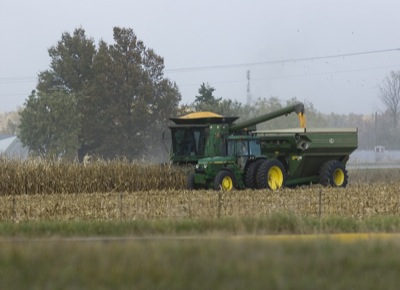Wednesday, October 21st, 2009
Farmers facing long, wet harvest
Mercer County rain falls when they don't need it
By Nancy Allen

Photo by Mark Pummell/The Daily Standard
A farmer harvests corn west of St. Marys on Tuesday evening. Wet fall weather may have some farmers taking off corn well into November and spending extra money on drying costs, local ag officials have said.
Local farmers may be harvesting corn into late November due to a wet fall that's kept them out of the fields.
Add that to this year's drought and lackluster yields, and a lot of producers are wringing their hands, local ag officials say.
"I won't be surprised if we're harvesting corn all the way up to Thanksgiving," said Jim Hoorman, Mercer County OSU Extension educator. "Unless we get some really, nice, warm days."
Crops already were behind in Mercer and Auglaize counties due to a wet spring that resulted in late planting. Summer rains never came and when it finally came time to harvest, the rains returned and shut farmers down.
About 70 percent of Mercer County's soybeans have been harvested compared to about 90 percent in a typical year and less than 15 percent of the corn is off, compared to the usual 50 percent, said Chris Gibbs, executive director of the Mercer County Farm Service Agency.
The wet fall weather also means farmers have to spend more on drying costs to get the moisture content down in their grain, Hoorman said.
"Corn moisture (percentage) is in about the 30s and generally we need it to be down to 15 percent to store," he said.
Mold can be an issue when grain is wet. Hoorman said most of the problems will likely be in the grain dryer if the grain is put in too wet.
"Guys will really have to watch their grain," he said. "We tell them to keep stirring it and keep blowing air through it to get rid of hot spots."
Mold is more likely to grow in hot spots and then the mold can attract insets that do further damage, Hoorman said. A concern for livestock farmers is that some molds produce toxins that can be harmful to animals.
Some producers may try to leave corn in their fields as long as possible to let it dry down on its own. But that only works if it doesn't rain, snow or get blown down, he said.
Gibbs said he's heard reports of hundreds of acres of corn blown down north and west of Celina and south of Grand Lake near the Auglaize County line about three weeks ago.
The late harvest also has resulted in farmers putting out less winter wheat because they didn't get their soybeans off in enough time to plant the wheat, he added.
Overall, ag officials say the yields are better than expected, likely due to continued improvements in drought-resistant crop varieties, but are still disappointing.
Gibbs said he's heard yields ranging from 10 to 40 bushels per acre for soybeans and 80 to 150 bushels per acre for corn. The average 2007 yield for soybeans was about 50 bushels per acre and for corn it was about 148, according to the Ohio Department of Agriculture USDA National Agricultural Statistics Service annual report.
The worst crops in the nation have been reported in a small area of about six counties that includes Mercer and Auglaize counties, even though record crops are being predicted nationwide this year, area grain merchandiser John Leighty has said.
In Mercer County, the areas north and west of Celina, starting at the village of Rockford south to state Route 29, were the worst hit by drought. Fields closer to Darke County, which received plenty of rain this growing season, look pretty good, Hoorman said.
With the return of dry, sunny weather this week, fields likely will be a blur of activity.
"From here on out, they'll be banging 'em out," Gibbs said.



